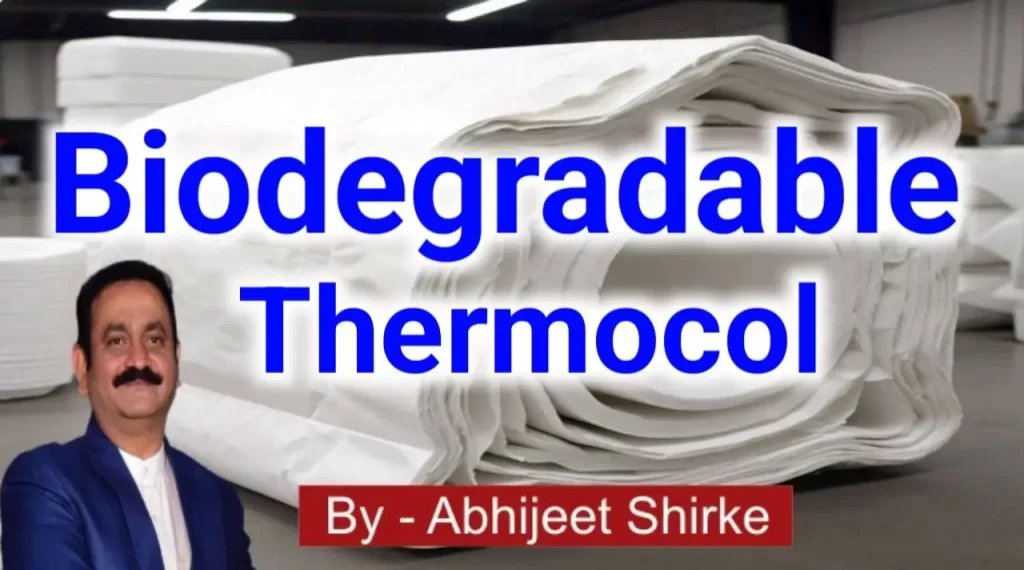
As global concern for environmental sustainability grows, the development of innovative and eco-friendly materials becomes imperative. Traditional expanded polystyrene (EPS) foam, commonly known as thermocol, is non-biodegradable and poses significant environmental challenges. In response, researchers have been exploring alternative materials made from biodegradable renewable resources that have characteristics comparable to those of EPS foam. This essay delves into the technical aspects of creating biodegradable thermocol from agricultural waste and fungus, highlighting materials, production processes, advantages, and potential applications of this promising eco-friendly solution.
Expanded polystyrene foam (thermocol) is widely used for packaging, insulation, and other applications due to its lightweight, insulating, and cushioning properties. However, its long-lasting environmental impact and challenges associated with recycling have prompted researchers to seek alternative solutions. Biodegradable materials derived from agricultural waste combined with fungal mycelium offer a sustainable substitute for traditional EPS foam.
Materials:
Agricultural byproducts such as rice husks, wheat straw, and corn stalks are rich in cellulose and lignocellulosic materials. These residues are readily available, low-cost, and renewable sources for biopolymer extraction.
2. Fungal Mycelium:
Mycelium, the vegetative part of fungi, has the remarkable ability to bind and grow around various substrates, forming a strong, interconnected network. This network structure can replace the polystyrene matrix in EPS foam, resulting in a biodegradable composite material.
Biodegradable Thermocol Production Process
1. Substrate Preparation:
Agricultural waste is collected, cleaned, and processed to obtain cellulose-rich fibers. These fibers are often broken down into smaller particles to enhance their surface area and increase their susceptibility to fungal colonisation.
2. Fungal Inoculation: Fungal spores or mycelium culture are introduced to the substrate. The mycelium starts to grow, feeding on the cellulose present in the agricultural waste. It binds the particles together, forming a cohesive matrix.
3. Mold Casting: The mycelium-infused substrate is placed into molds of desired shapes and sizes. Under controlled conditions of temperature and humidity, the mycelium continues to grow and solidify, filling the mold cavity.
4. Hydration and Drying: After the mycelium has adequately colonized the substrate, the composite material is dehydrated to stop fungal growth. This drying process strengthens the material and enhances its structural integrity.
5. Post-Processing: The biodegradable thermocol is trimmed, cut, and shaped as needed for various applications. Surface treatments might also be applied to enhance durability and water resistance.
Advantages:
1. Environmental Sustainability: Biodegradable Thermocol reduces the burden of non-biodegradable waste on landfills and ecosystems.
2. Renewable Source: Agricultural waste is abundant and widely available, offering a sustainable source for material production.
3. Reduced Energy Consumption: The production process requires lower energy inputs compared to the energy-intensive manufacturing of traditional EPS foam.
4. Customizability: Biodegradable thermocol can be molded into various shapes, sizes, and densities, making it suitable for numerous applications.
5. Biocompatibility: The materials used are biocompatible and pose minimal health risks to humans and the environment.
Potential Applications:
1. Packaging: Biodegradable thermocol can be used for protective packaging, reducing plastic waste in the shipping and logistics industry.
2. Construction: The material can serve as insulation panels, reducing energy consumption in structures and contributing to sustainable construction practices.
3. Agricultural Uses: Biodegradable plant pots and trays are assembled, reducing waste in nurseries and garden centers.
4. Consumer Goods: The material’s versatility allows for the production of disposable utensils, food containers, and other single-use items.
5. Art and Design: The unique aesthetic and texture of biodegradable thermocol can be utilised in art, design, and architectural applications.
Current Status:
Biodegradable thermocol development from agricultural waste and fungi, is at an advanced stage in India. Research has focused on identifying suitable agriculture residues such as rice husks, wheat straw, and sugarcane bagasse, which are abundant and often discarded. These waste materials are processed to extract cellulose, a primary component used in thermocol production. Additionally, fungi, such as mycelium, are used to bind the cellulose particles, forming a biodegradable and sturdy material.
Researchers and startups have made significant strides in optimising the production process, enhancing material properties, and conducting real-world tests. The resulting biodegradable thermocol exhibits qualities similar to those of traditional EPS foam in insulation, shock absorption, and lightweight characteristics.
Value Added Products:
The development of biodegradable thermocol has led to the creation of various value-added products. These include packaging materials for fragile goods, thermal insulation panels for construction, agricultural mulch films, and disposable tableware. These products not only fulfill market demands but also align with sustainability goals by reducing the environmental impact associated with plastic waste.
Employment Opportunity:
The adoption of biodegradable thermocol technology has opened doors to a plethora of employment opportunities. From research and development to manufacturing, distribution, and sales, the entire value chain needs a skilled workforce. This innovation supports India’s goal of fostering a knowledge-based economy, as skilled labour is needed for technological advancements and sustainable production.
Government of India Support:
The Government of India has extended support for biodegradable thermocol technology through a number of programs, seeing its potential. To speed up research and development in this area, financial incentives, research grants, and collaborations with academic institutions and businesses have been formed. Additionally, frameworks for regulations are being developed to promote the use of biodegradable materials and prohibit the use of traditional plastics.
Contribution to GDP:
The adoption of biodegradable thermocol technology has the potential to significantly contribute to India’s GDP. By replacing imported plastics and reducing environmental remediation costs associated with plastic pollution, the technology supports economic growth. The development of a thriving biodegradable thermocol industry also generates revenue and employment opportunities, contributing to the overall economic landscape of the nation.
The advent of biodegradable thermocol from agricultural waste and fungi in India represents a promising advancement towards sustainability and environmental responsibility. As the technology matures, it offers a range of value-added products, generates employment opportunities, receives government support, and contributes to India’s GDP. By embracing this innovation, India can position itself as a global leader in sustainable materials and set an example for other nations seeking to mitigate plastic pollution and promote green growth.